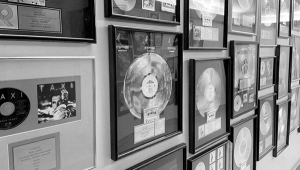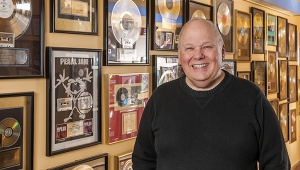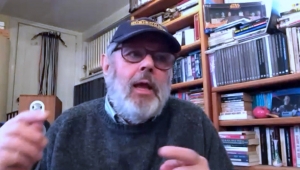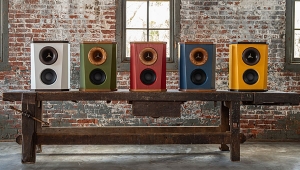| Columns Retired Columns & Blogs |
John Crabbe: Firebrand
Editor's Note: John Crabbe was Editor of Hi-Fi News & Record Review when I joined that magazine as a lowly editorial assistant in September 1976. At the end of 2007, I had asked Steve Harris to interview John for Stereophile, as part of an ongoing project to create an oral history of high-end audio (footnote 1). Sadly, John passed away in December 2008—see "As We See It" and "Industry Update," in our March issue. We are publishing Steve's interview as a tribute to a man from whom I learned my craft as an audio magazine editor.—John Atkinson
Footnote 1: Stereophile's interviews with the movers and shakers of audio can be found reprinted in the magazine's free on-line archives.—Ed.

America already had High Fidelity and Audio when the first British hi-fi magazine emerged. Before that, to find coverage of audio developments you'd have had to search through the pages of Wireless World, the major technical journal that covered the entire field of electronics. But in June 1956, just a couple of months after the first London Audio Fair, came the first issue of Hi-Fi News. Later, at least for a few golden years in the 1960s, there was still really only one hi-fi magazine, and there was only one Editor: John Crabbe.
John Crabbe joined Hi-Fi News in 1962, and was Editor from 1965 to 1982. Early in his tenure he wrote one of the best books ever on the subject, Hi-Fi in the Home, and by the end of it he'd also managed to find time to write books about Berlioz and Beethoven.
John used to like to say that he was the only audio editor who'd once driven his own pigs to market, and he was surely the only one to have had tea with Bertrand Russell. He must still be the only one to have published a limerick-writing competition, or to have delivered an awards citation in verse.
Under John's editorship of Hi-Fi News there was always a vein of whimsical and rather eccentric humor. Much more important, though, was the way he established a lasting ethos for the magazine, combining technical and factual accuracy with unshakable integrity and a mission to inform and educate.
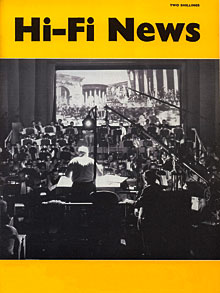 You could say that John Crabbe was in the right place at the right time, but it's just as true to say that he was the right person to be there. Born in 1929, he began his working life in 1946, with Decca.
You could say that John Crabbe was in the right place at the right time, but it's just as true to say that he was the right person to be there. Born in 1929, he began his working life in 1946, with Decca.
"I left my technical secondary school," he remembers, "having done what was supposed to be an engineering-based course. I was very electrically minded, and used to build all sorts of things, early radios and goodness knows what, and I was also very good on the drawing side. I applied for a job as draughtsman to various firms.
"But I lived in Brixton, in South London, and just up the road there was the Decca Record Company and its associated firms, in this huge building near The Oval cricket ground. A friend of my mother's had some connection there and asked if they had any vacancies for a young technical assistant. I had an interview, and that was it!
"The word Decca suggests recording, but it was the Decca Navigator company using that building. This was a new radio navigational aid which actually was used to help take the invasion force into Europe in 1944, by providing a sort of quasi-radar–type coverage. They went into radar later. It was a phase-difference long-wave thing, working down at frequencies centered around 100kHz, with transmitters creating wave interference patterns.
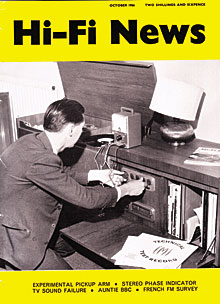 "The receiver for this—it was all valves, of course—had a great big amplifier with phase detectors within it. It was about 18 inches square, with about 50 or so valves and lots and lots of tuned circuits. It fell to me to test and measure all these tuned circuits and coils on a special test bench, peak them up so that they tuned in to the right harmonics of a fundamental oscillator."
"The receiver for this—it was all valves, of course—had a great big amplifier with phase detectors within it. It was about 18 inches square, with about 50 or so valves and lots and lots of tuned circuits. It fell to me to test and measure all these tuned circuits and coils on a special test bench, peak them up so that they tuned in to the right harmonics of a fundamental oscillator."
Decca's Navigator system continued to provide a terrestrial-radio navigation service for more than 50 years, until finally superseded by the Global Positioning System (GPS); it was closed down in 2000.
"That factory wasn't only making Navigators, they were making radios, pickups, and record players. All the audio people were just behind me when I was working there, and I used to get bits and pieces from them. Decca's pioneering lightweight pickup [cartridge], the XMS, was being developed while I was there. By the standards of the day it was relatively free, laterally; it had a high lateral compliance. It had a removable T-shaped armature, with a sapphire stylus.
"The eventual plug-in pickup head was a plastic molding. But they had made a mock-up out of bent pieces of aluminum, a skeletal thing into which the armature assembly fitted, perfectly workable. A chap there who knew my interest gave it to me! And they gave me some T-pieces with a variety of different styli to play around with. Already, by then, the notion of the elliptical stylus had come up, and they had an elliptical tip available as a special on the XMS.
Footnote 1: Stereophile's interviews with the movers and shakers of audio can be found reprinted in the magazine's free on-line archives.—Ed.
- Log in or register to post comments

